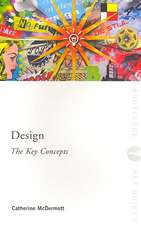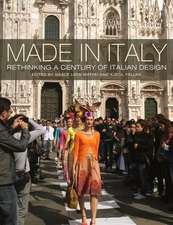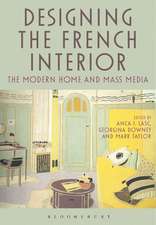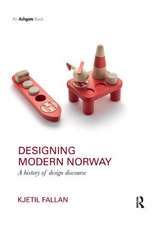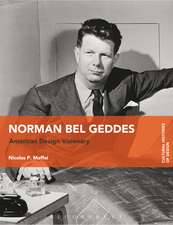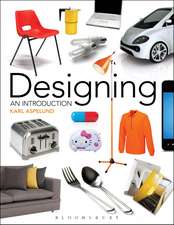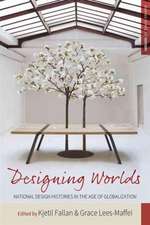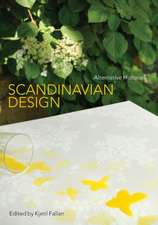Design History: Understanding Theory and Method
Autor Kjetil Fallanen Limba Engleză Paperback – 31 dec 2009
| Toate formatele și edițiile | Preț | Express |
|---|---|---|
| Paperback (1) | 223.67 lei 6-8 săpt. | |
| Bloomsbury Publishing – 31 dec 2009 | 223.67 lei 6-8 săpt. | |
| Hardback (1) | 596.40 lei 6-8 săpt. | |
| Bloomsbury Publishing – 31 dec 2009 | 596.40 lei 6-8 săpt. |
Preț: 223.67 lei
Preț vechi: 257.23 lei
-13% Nou
Puncte Express: 336
Preț estimativ în valută:
42.80€ • 44.69$ • 35.42£
42.80€ • 44.69$ • 35.42£
Carte tipărită la comandă
Livrare economică 04-18 aprilie
Preluare comenzi: 021 569.72.76
Specificații
ISBN-13: 9781847885371
ISBN-10: 1847885373
Pagini: 224
Ilustrații: 20 b&w illustrations, bibliography, index
Dimensiuni: 150 x 189 x 13 mm
Greutate: 0.32 kg
Editura: Bloomsbury Publishing
Colecția Berg Publishers
Locul publicării:London, United Kingdom
ISBN-10: 1847885373
Pagini: 224
Ilustrații: 20 b&w illustrations, bibliography, index
Dimensiuni: 150 x 189 x 13 mm
Greutate: 0.32 kg
Editura: Bloomsbury Publishing
Colecția Berg Publishers
Locul publicării:London, United Kingdom
Caracteristici
Methods are the most difficult part of a Design course for most students. This book presents a short and accessible overview of all the key methodologies of Design History & Theory
Notă biografică
Kjetil Fallan is Associate Professor of Design History in the Dept of Philosophy, Classics, History of Art and Ideas at the University of Oslo.
Cuprins
Introduction1: Historiography2: Theory and Methodology3: EpistemologyConclusionBibliographyIndex
Recenzii
This essential guide to the field of design history offers a nuanced survey of ongoing debates, suggests the use of new interdisciplinary performance theories, and clarifies epistemological issues surrounding design and modernization.
Fallan's methodological survey is opinionated, sharp and persuasive... This is an extremely useful and engaging account.
Addressing the various changes which have occurred in the writing of design history since its emergence as a discrete discipline, Design History is an accessible yet authoritative analysis of a variety of methodological frameworks, assessing their suitability and relative merits for the design historian....A massively useful resource.
This book will be of great value to scholars in the field of Design as an overview and critique of a highly interdisciplinary field. It will be of even more value to students for its explanation of the historiography and methodology of Design Studies and for the way it strengthens our understanding of Design History.
The standard historiographic reading for students of design history.
Thoughtful and provocative ... a timely contribution to the field.
Kjetil Fallan's slim blue paperback is a refreshingly readable guidebook to contemporary issues in design history, theory, and methods. Clearly organized and succinct, it nevertheless covers a considerable amount of ground, from historiography, to a selection of methods, to epistemology.
In totality [Design History is] more than just a teaching or study resource. As [it] advocate[s] that the production, consumption and mediation of designed objects and images affect everyone, [it] will be of interest to both informed and general readerships. Design History's introduction tentatively offers that design history might be seen as a field of cultural history - although, as the volume unfolds, robustly demonstrates that it is... indeed this is a great strength [of Design History]: the effective demonstration that design analysis and history is not an elitist, purely academic pursuit, but essential to consideration of society and its cultural expressions in the very broadest sense.
In a tight, efficient argument, not without occasional dashes of humour, Fallan carefully reviews the development of design history since the mid-twentieth century, usefully citing a wealth of seminal articles and studies. But the book goes further, opening up methodological assumptions and poking fun at their inner organs: here design history becomes both the subject of description and the object of analysis.Design History is an extremely useful book. It is a sharp analysis of the development of design history, and a clear guide through the field's current iterations. Fallan disassembles both analytical methods and conceptions of histories and lays their parts bare . . . His purpose is not to complete a discussion but to begin one; to open up design history to rethinking, so that it can better intersect with social science, cultural studies, and other allied fields.
Fallan's methodological survey is opinionated, sharp and persuasive... This is an extremely useful and engaging account.
Addressing the various changes which have occurred in the writing of design history since its emergence as a discrete discipline, Design History is an accessible yet authoritative analysis of a variety of methodological frameworks, assessing their suitability and relative merits for the design historian....A massively useful resource.
This book will be of great value to scholars in the field of Design as an overview and critique of a highly interdisciplinary field. It will be of even more value to students for its explanation of the historiography and methodology of Design Studies and for the way it strengthens our understanding of Design History.
The standard historiographic reading for students of design history.
Thoughtful and provocative ... a timely contribution to the field.
Kjetil Fallan's slim blue paperback is a refreshingly readable guidebook to contemporary issues in design history, theory, and methods. Clearly organized and succinct, it nevertheless covers a considerable amount of ground, from historiography, to a selection of methods, to epistemology.
In totality [Design History is] more than just a teaching or study resource. As [it] advocate[s] that the production, consumption and mediation of designed objects and images affect everyone, [it] will be of interest to both informed and general readerships. Design History's introduction tentatively offers that design history might be seen as a field of cultural history - although, as the volume unfolds, robustly demonstrates that it is... indeed this is a great strength [of Design History]: the effective demonstration that design analysis and history is not an elitist, purely academic pursuit, but essential to consideration of society and its cultural expressions in the very broadest sense.
In a tight, efficient argument, not without occasional dashes of humour, Fallan carefully reviews the development of design history since the mid-twentieth century, usefully citing a wealth of seminal articles and studies. But the book goes further, opening up methodological assumptions and poking fun at their inner organs: here design history becomes both the subject of description and the object of analysis.Design History is an extremely useful book. It is a sharp analysis of the development of design history, and a clear guide through the field's current iterations. Fallan disassembles both analytical methods and conceptions of histories and lays their parts bare . . . His purpose is not to complete a discussion but to begin one; to open up design history to rethinking, so that it can better intersect with social science, cultural studies, and other allied fields.
Descriere
A student introduction to the methods and techniques of studying Design History

